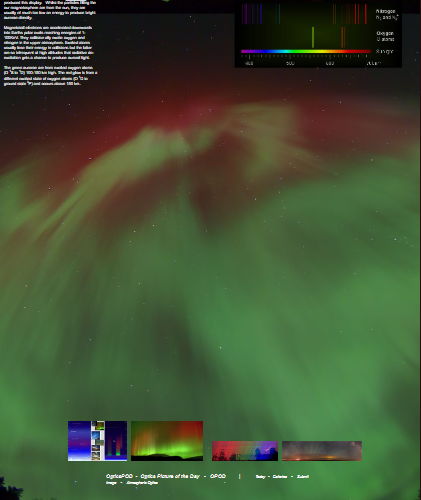OPOD - Aurorae
OPOD - Aurorae: A Spectacular Display of Nature's Light Show
Aurorae, also known as the Northern and Southern Lights, are one of nature's most captivating phenomena. These mesmerizing light displays occur in the polar regions and have been a source of fascination for centuries. In this article, we will delve into the intricate mechanisms behind aurorae and explore the different types of light they emit.
The Science Behind Aurorae
Aurorae are produced by electrons from Earth's night-side magnetotail. Although the particles that fill our magnetosphere originate from the sun, they are typically not energetic enough to generate bright aurorae directly. However, magnetotail electrons, accelerated downwards into Earth's polar ovals, reach energies ranging from 1 to 100 kiloelectronvolts (KeV).
When these high-energy electrons collide with oxygen and nitrogen atoms in the upper atmosphere, they excite them. Normally, excited atoms lose their energy through collisions, but at high altitudes, such collisions are infrequent. This allows for radiative de-excitation to occur, resulting in the production of auroral light.
Unveiling the Colors of Aurorae
Aurorae exhibit a stunning array of colors, with green and red being the most common hues observed. The green aurorae stem from excited oxygen atoms (O 1S to 1D) located approximately 100-150 kilometers above the Earth's surface. On the other hand, the red glow originates from a different excited state of oxygen atoms (O 1D to ground state 3P) and occurs at altitudes above 150 kilometers.
Exploring the Beauty of Aurorae
When witnessing an aurora, it is truly a sight to behold. The vibrant colors dance across the night sky, creating an ethereal spectacle. Here are some key points to consider when exploring the beauty of aurorae:
-
Location: Aurorae are primarily visible in polar regions, such as the Arctic and Antarctic. However, during periods of high solar activity, they can be observed at lower latitudes as well.
-
Time of Year: The best time to catch a glimpse of aurorae is during the winter months when the nights are long and dark. However, they can occur throughout the year, provided the conditions are right.
-
Solar Activity: Aurorae are closely tied to solar activity, particularly solar flares and coronal mass ejections. When these events eject charged particles towards Earth, they interact with our planet's magnetic field, giving rise to the mesmerizing light displays.
-
Dark Skies: To fully appreciate the beauty of aurorae, it is essential to find a location away from light pollution. Dark skies enhance the visibility of these natural wonders and allow for a more immersive experience.
The Magic of Aurorae Photography
Capturing the enchanting beauty of aurorae through photography has become increasingly popular. Here are some tips for photographing these captivating light displays:
-
Equipment: A digital camera with manual settings, a wide-angle lens, and a sturdy tripod are essential for aurora photography. Additionally, remote shutter releases or self-timers can help minimize camera shake.
-
Exposure Settings: Experimenting with different exposure settings is crucial for capturing the vivid colors and delicate details of aurorae. Generally, using a long exposure time (around 15 seconds or more) and a low ISO setting (e.g., ISO 400) can yield excellent results.
-
Composition: Incorporating interesting foreground elements, such as trees, mountains, or bodies of water, can add depth and context to your aurora photographs. Additionally, composing your shot with the aurora as the focal point can create a visually striking image.
Conclusion
Aurorae are nature's awe-inspiring light show, captivating viewers with their vibrant colors and celestial dance. Understanding the science behind these phenomena and knowing when and where to observe them can enhance the experience of witnessing this magical display. Whether you're an avid photographer or simply an admirer of nature's wonders, aurorae never fail to leave a lasting impression. So, keep your eyes on the night sky and prepare to be mesmerized by the captivating beauty of aurorae.

Aurorae, Norway
Seen by Marius Sollerud 26th Sept '11 at Bysetermåsan, 10 miles SE of Oslo. Olympus E3, 8 mm fisheye-lens. 15 sec, ISO 400, F/3,5
©Marius Sollerud, shown with permission.

Electrons from Earth�s night-side magnetotail produced this display. Whilst the particles filling the our magnetosphere are from the sun, they are usually of much too low an energy to produce bright aurorae directly.
Magnetotail electrons are accelerated downwards into Earths polar ovals reaching energies of 1-100KeV. They collision ally excite oxygen and nitrogen in the upper atmosphere. Excited atoms usually lose their energy in collisions but the latter are so infrequent at high altitudes that radiative de-excitation gets a chance to produce auroral light.
The green aurorae are from excited oxygen atoms (O 1S to 1D) 100-150 km high. The red glow is from a different excited state of oxygen atoms (O 1D to ground state 3P) and occurs above 150 km.

Note: this article has been automatically converted from the old site and may not appear as intended. You can find the original article here.
Reference Atmospheric Optics
If you use any of the definitions, information, or data presented on Atmospheric Optics, please copy the link or reference below to properly credit us as the reference source. Thank you!
-
<a href="https://atoptics.co.uk/blog/opod-aurorae/">OPOD - Aurorae</a>
-
"OPOD - Aurorae". Atmospheric Optics. Accessed on November 17, 2024. https://atoptics.co.uk/blog/opod-aurorae/.
-
"OPOD - Aurorae". Atmospheric Optics, https://atoptics.co.uk/blog/opod-aurorae/. Accessed 17 November, 2024
-
OPOD - Aurorae. Atmospheric Optics. Retrieved from https://atoptics.co.uk/blog/opod-aurorae/.